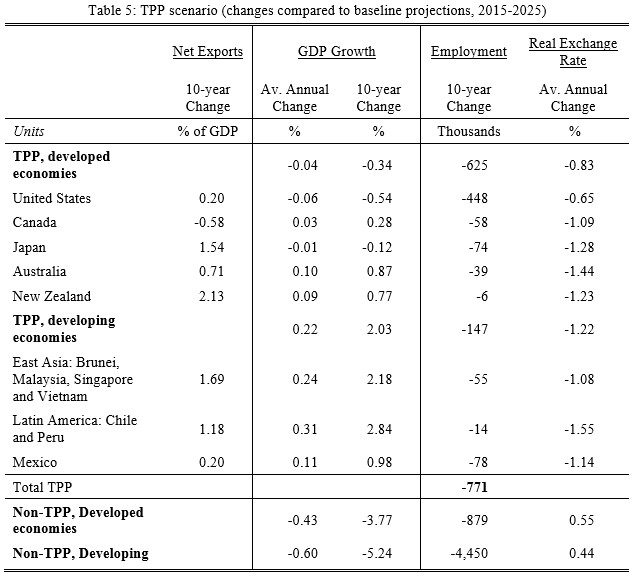Modelling by the Peterson Institute for International Economics suggests that Australia’s national income would have been boosted by 0.6% had the proposed Trans-Pacific Partnership (TPP) included the US. However, even without the US, the TPP is tipped to increase Australia’s national income by 0.5%, according to the Peterson Institute, with Trade Minister Steve Ciobo using the modelling to push for a TPP Mark 2 at the APEC summit in Vietnam in November. From The AFR:
A revived agreement between Australia and 10 other members would deliver a fresh riposte against the anti-trade rhetoric of Donald Trump…
Rising prospects of a deal would also put renewed pressure on Labor, whose union base and left-wing membership argues the so-called Trans-Pacific Partnership is flawed because the gains are too modest.
That argument has been challenged by detailed work done by the Peterson Institute for International Economics, released this month, which shows the original TPP with the US would have boosted Australia’s national income by $19 billion – or 0.6 per cent – and lifted exports by another $37 billion by 2030.
Without the US, according to the study, those numbers fall only slightly; national income would be 0.5 per cent higher and the export gain would be $29 billion…
Trade Minister Stephen Ciobo described chances of clinching an APEC win next month as “solid”, with officials from the TPPII ordered to deliver the outline of an agreement without the US in time for the Da Nang meeting…
“The TPP11 provides opportunity for major economies to continue to demonstrate to the world that we will work to liberalise trade investment, knowing it drives economic growth and employment,” Mr Ciobo told The Australian Financial Review on Sunday…
Mr Ciobo took a shot at Labor’s position on the TPP, accusing the opposition of being happy to see the deal killed off to appease “a pro-protectionist attitude, starting in the union movement, which then permeates the Labor parliamentary wing”…
Opposition trade spokesman Jason Clare insisted that Labor supported any trade deal that benefited Australian workers, farmers and businesses, and that the opposition would “consider any new agreement on its merits”.
However, he said the economic benefits of the original TPP were modest and that the modelling showed those gains had fallen further without US inclusion.
He urged the government to use the opportunity of a new deal to remove clauses in the original that hurt workers, such as the waiving of labour market testing for an additional six countries. “Labor urges the government to make the most of this opportunity and put Australian workers first,” he said.
The suggestion that the TPP, even without the US, would deliver big economic dividends to Australia is ridiculous.
The Peterson Institute’s own modelling of a 0.5% boost in national income from the TPP is immaterial, given that Australia’s real gross national income has increased on average by 0.9% each quarter since 1959. So we are talking about a boost to national income equivalent to only around 1.5 months of output. Whoopdee do.
Besides, separate modelling by the Global Development and Environment Institute at Tufts University actually found that the TPP (including the US) “would lead to losses in employment and increases in inequality”, with employment in Australia estimated to contract by 39,000 jobs:

There are also several potential costs that are unlikely to have been captured by the TPP modelling. These include Investor-State Dispute Settlement (ISDS) provisions – which would open the door to multinational companies suing the Australian Government for implementing rules against their interests (e.g. on environmental, health and safety grounds) – as well as agreed extensions to patent and copyright protections.
In any event, the Productivity Commission has previously called for greater oversight and scrutiny of FTAs:
The emerging and growing potential for trade preferences to impose net costs on the community presents a compelling case for the final text of an agreement to be rigorously analysed before signing. Analysis undertaken for the Japan-Australia agreement reveals a wide and concerning gap compared to the Commission’s view of rigorous assessment.
Similarly, a Parliamentary committee also slammed the lack of adequate “oversight and scrutiny” pertaining to the TPP, and lamented that “parliament is faced with an all-or-nothing choice” on whether or not to approve trade agreements and can only officially review trade laws once they have officially passed.
The original TPP was an incredibly complex agreement whose text numbered some 6,000 pages and 30 chapters. It was far too complex for the Joint Standing Committee on Treaties (JSCOT) to comprehensively review and required expert scrutiny from the PC prior to any parliamentary vote to ratify the agreement.
That said, with the US now out of the picture – who was the nation driving ghastly clauses like ISDS and patent and copyright extensions – there is at least the opportunity for a more friendly deal to be negotiated between the remaining member countries. But this requires transparency, not the opaque and secretive processes that have been used thus far in Australia’s FTA negotiations.
Now watch on as the Coalition attempts to sell us down the river yet again.

